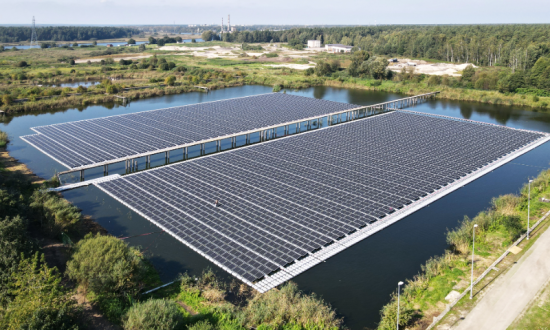Recom Technologies leading European Bloomberg Tier 1 PV module manufacturer developed the first floating solar power station in Latvia, in cooperation with our valuable partner Derex, a proficient player in the realm of renewable energy. The floating station, boasting a capacity of 2.1 MW, situated on the water’s surface using floating pontoons, will provide the necessary energy for the full operation of the wastewater treatment plant ‘Sloka’ (‘Jūrmalas ūdens’ water utility) in Jurmala, Latvia.
The solar modules used in the power station – RECOM Panther 550Wp Half Cut mono bifacial double glass frameless solar modules – are designed to produce no less than 87.20% of their nominal power in the 25th year from the warranty start date surpassing industry’s average for Half Cut technology, thus securing high return on investment.
The ‘Sloka’ WWTP consumes 40% of the total energy expenses of ‘Jūrmalas ūdens’. The installation of the solar station will enable ‘Sloka’ to generate its own energy, effectively lowering the electricity costs of ‘Jūrmalas ūdens’ and reducing the organization’s reliance on fluctuations in energy market rates. The project aims to reduce carbon dioxide emissions by 231,657 tonnes per year, which will decrease the region’s carbon footprint and help preserve its resources in the long term, maintaining ecological balance. Over the guaranteed 30-year service life, the floating solar station will be able to operate continuously in the harsh local environment. Thanks to specially designed solutions, the system is resistant to salt, fog, snow, and ice — typical precipitation in the Latvian climate — as well as to the effects of ammonia and hydrogen sulfide on the station’s materials and equipment.
Utilizing Water Bodies for Solar Power Plant Installation: Reasons and Approach Positives
The decision to choose a location for the installation of a floating—type power plant was made taking into account technical and energy efficiency, as well as the landscape features of Jurmala. The city is surrounded by the Lielupe River, the Gulf of Riga, and the Kemeri National Park, and is covered by 64% natural areas, including forests and water bodies. 16% of the territory consists of reserves and nature conservation areas with rare species of flora and fauna. Since it was impossible to install a solar station on the ground, an unused pond in the western part of the ‘Sloka’ WWTP was chosen as the installation site.
Mrs Tatiana Panchenko, MBA, Recom’s Sales and Business Development Director has commented on the project realization: “It has been a real pleasure cooperating with DEREX in this important project. On behalf of Recom Technologies, I would like to express our gratitude to DEREX for the trust in our high efficient products. We will be absolutely happy to realize more solar projects together for a more sustainable and greener environment!“
“Floating stations have not gained significant popularity in Latvia and the Baltic region yet, although this is the safest option for the fragile ecosystems typical of the region. The ‘islands’ on the water protect the surface from excessive sunlight, preventing the growth of underwater vegetation and preserving the balance and purity of the water ecosystem,” explains Yulia Nikulina, project manager and director of the DEREX green energy division. “Furthermore, the water environment is optimal for the panels themselves, as the natural cooling effect of the water helps the station maintain a stable temperature. Even higher station performance is achieved by bifacial (two-sided) panels, which absorb the reflection of the sun from the surface of the water.”
Technical Review
The project includes 3,820 frameless RECOM Panther Half Cut bifacial double glass modules, each with a power output of 550 Wp. They are installed on the ‘island’ at a 12° angle to optimize sunlight collection. The floating system consists of an array with anchor points on a three-layer architecture:
- The bottom layer is a float made of HDPE.
- The middle layer is a steel rod with anchor points.
- The top layer is the solar module.
The floats between rows of modules are positioned at a distance from each other, reducing shading effects and ensuring accessibility for maintenance.






